Regenerative Biophilic Residential Design: HOPEone
The governments inability to appropriately address the ecological crisis has inspired the conception of the HOPE project to develop decentralized self-sufficient housing models that provide citizens with the opportunity to take action into their own hands as buildings currently consume 40% of the global energy and produce 37% of the global carbon emissions.
The quest of the HOPE Project is to develop regenerative biophilic residential buildings in four climatic zones that integrate a water-energy-waste-food nexus to set a standard for regenerative biophilic building design while achieving 10 of the 17 United Nations Sustainable Development Goals in addition to integrating a solution for residential carbon sequestration. These autonomous buildings integrate renewable energy, sustainable water and regenerative food systems while ecologically processing biogenic waste streams and sequestering carbon.
The first model, HOPEone was built in a subtropical climate with an emphasis to develop a carbon negative biogenic energy system to demonstrate the feasibility of integrating a next generation biogenic natural gas (BioNG) generator that provides energy for cooking and domestic hot water. Another highlight of the HOPEone model is the novel residential biogenic battery to store seasonal energy during the summer that can be utilized in the winter. HOPEone generates energy from renewable resources, collects water from rain, processes biowaste and converts it to BioNG and organic fertilizer while sequestering carbon dioxide and providing a healthy habitat.
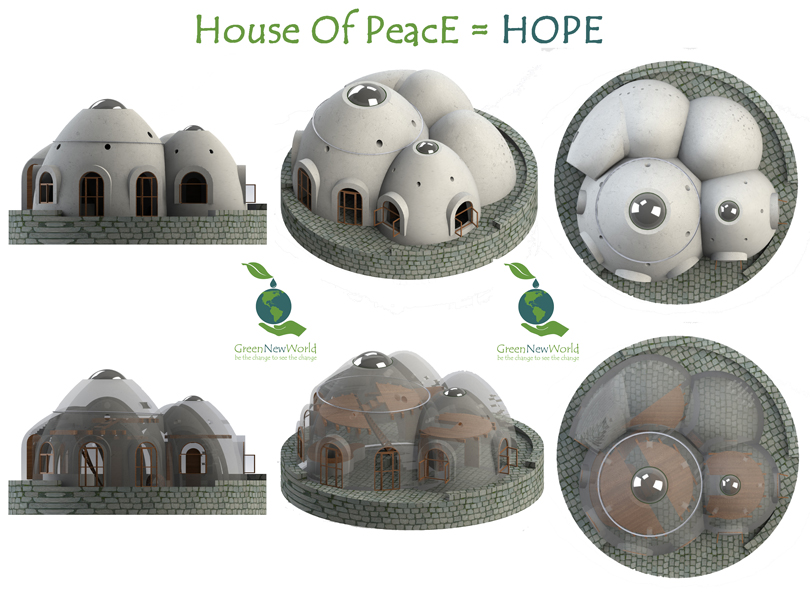
Features Of HOPEone:
Hybrid Alternative Electric Energy Generation
Residential Anaerobic Bioreactor - Waste to Energy
BioNG for Residential Hot Water and Cooking
Residential Biowaste Processing Produces Organic Fertilizer
Residential Photobioreactor - Solar Powered Carbon Dioxide Scrubber
Biomass Gasification - Carbon Negative Thermal Energy
Earth Domes
Superadobe was selected as a sustainable building technology for the envelope of HOPEone to create earthen domes. Domes provide many benefits compared to conventional cubical buildings. The Geometry of domes reduces building materials by 40%, provides efficient interior climate control and displays resistance to fires, hurricanes and earthquakes while using 95% of the materials from the building site. This combination of resiliency and ecology make Superadobe domes a favorable building method in climates where thermal mass is advantageous. While being labor intensive the level of skill required is minimal and hence can easily be built by one skilled person accompanied by unskilled helpers.
Earthen structures are biophilic as they provide a healthy non-toxic environment with the earths ability to act as a climate buffer to regulate moisture and temperature. A special lime based natural exterior finish was developed to ensure the domes are breathable while enduring the elements. After seven years of experimentation and testing a satisfying solution was obtained which was applied to HOPEone in 2017 and has ever since received 7000 mm of rain and withstood a 7.4 magnitude earthquake.
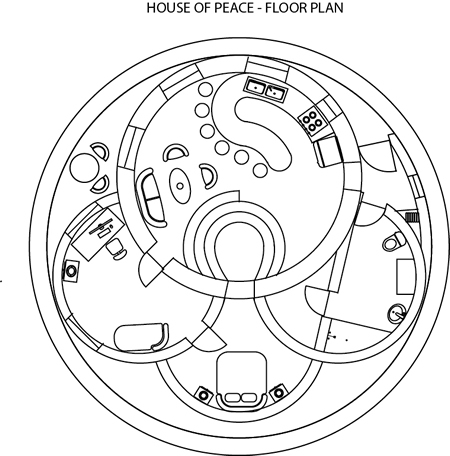
Passive Thermal Design
Due to poor design conventional buildings consume most of the energy for heating, ventilation and cooling (HVAC). A multitude of passive building design strategies exist to reduce energy consumption of buildings such as building geometry, orientation, insulation, thermal mass, seasonal shading, solar gain, evaporative cooling, wind catchment and solar ventilation. These elements can be used in isolation or in combination with one another. In scenarios where passive design elements are insufficient, energy-efficient active systems such as ground sourced heat pumps and biomass heaters are added. One of the key features of Green New World's passive design includes a positive interior air pressure to eliminate drafts and aid in convection driven passive geothermal ventilation. The inclusion of thermal mass increases inertia and provides a stable interior climate with less fluctuations.
HOPEone was built in a subtropical location with cool nights (5 - 15 C) and warm days (15 - 30 C) where passive elements are adequate to sustain a stable interior temperature of 18 - 21 C (66 F - 72 F) throughout the year. Some of the passive elements in HOPEone include 50 tons of thermal mass in the interior earthen walls which is sustained through the daily solar radiation of the dome's apex and can be further heated by the biomass heater. Shading off the exterior lower walls, entrances and windows prevent excess heat from entering during warmer months while upper portions of the building receive solar radiation to heat the thermal mass. A convective passive geothermal HVAC system provides additional support at keeping the building at an optimal temperature. Domes provide a superior thermal performance in comparison to cubical structures as the geometry naturally drives convection currents to the apex where it leaves through vents that result in drawing fresh air from the geothermal air-intake blowing cooled air into the building. This natural self-regulating HVAC system is inspired by termite burrows the warmer the air is, the stronger are the convective currents resulting in a stronger cooling effect. On cold days the same geothermal air-intake can be heated by the biomass gasifier.
Rainwater Harvesting
One of the core objectives of the HOPE Project is to demonstrate autonomous and sustainable water harvesting systems with emphasis on rain and air-moisture catchment (HOPEtwo). The abundance of water at the HOPEone location only necessitates a simple rain catchment system as there is an artesian spring on site. The system design and sizing for rain catchment depends on the distribution and amount of rainfall as well as the consumption of inhabitants. With a catchment area of 50m2 and an average rainfall above 1000 mm per year this system can potentially collect 50,000 liters of water per year, which is roughly twice as much as consumption estimates require. The collection tanks are treated with ozone and pass through a 3 stage purification, mineralization and balkanization treatment system.
Radical Water Conservation
HOPEone integrates a water recycling module that uses every drop of water 4-times reducing water consumption by 40-50%! Water from taps and showers are filtered through a greywater processing unit while watering indoor plants and then reused to flush an Ultra High Efficiency (UHE) flush toilet that converges with other biowastes into an anaerobic bioreactor. After digestion and filtration it provides safe landscape irrigation through a leachfield. In addition, water-saving shower heads and faucets are installed to further reduce consumption.
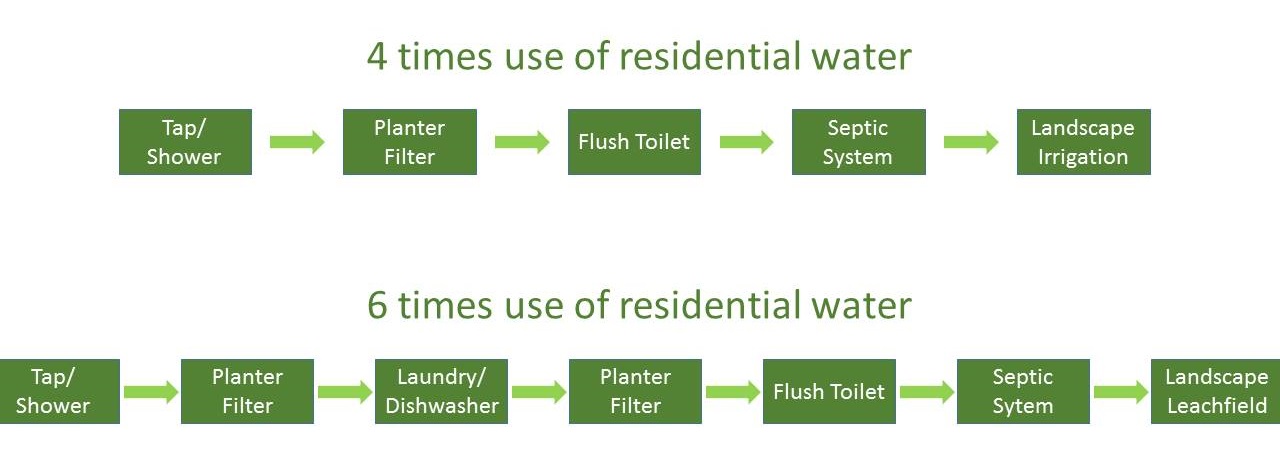
Holistic Water Treatment
Special consideration is given to water treatment. Holistic water treatment is distinct from conventional water treatment systems as only biophilic (life supporting) and ecological processes are selected. For example, ozone is used instead of chlorine for disinfection. The source of water and it’s contaminants determine the configuration of the water treatment modules which consists of up to 5 modules that filter, purify, disinfect, mineralize and balance the alkalinity.
Hybrid Alternative Electric Energy Generation - Resilient Synergy
Photo voltaic (PV) and wind power have become the most affordable methods to generate electricity. There is a current trend to electrify many aspects of our lives that still rely on fossil fuels such as vehicles and domestic appliances. However there is a concern that it is unsustainable due to mining of many minerals which leads to further ecological degradation. Regardless of all ecological solutions it is imperative to reduce consumption and improve energy efficicency. Therefore the first step in any regenerative system design is to improve efficiency and enhance conservation to reduce the ecological footprint. In HOPEone this is achieved by using energy star appliances and LED lights while diverting most heating applications to thermal solar and biomass. This way it was possible to reduce the daily electrical consumption to around 3 KWH!
Integration of a hybrid system provides flexibility and robustness so that even on cloudy days batteries are not depleted. Hybrid systems can be grid tied, off-grid or integrated in a micro-grid. Energy is generated by 1.3 KW of PV panels and a 200 W waste heat thermoelectric generator. The battery bank has a storage capacity of 4.8 KWH. With an average daily insolation of 4.6 kWh/m2 HOPEone generates more than twice the average electrical energy demand. So that under normal circumstances PV is more than adequate. The TEG unit has the benefit that it can be operated anytime to provide power and charge the batteries therefore reducing the size of the battery bank from three days to one day. This is particularly useful to reduce the need for storage when PV is used in the daytime and waste heat TEG is used at night time.
Residential Anaerobic Bioreactor - Convergence of Waste, Water and Energy
HOPEone integrates a residential zero waste systems with a triple stage isothemic and isobaric anaerobic bioreactor providing unmatched efficiency. Residential biowaste including fecal matter is processed to efficiently volatilize carbon while treating waste water and separating it into the three phases. The solids also known as sludge are converted to biochar or fertilizer both which are carbon negative applications while the liquid effluent is further treated by the photoautotrophic bioreactor to extract a large part of the remaining nutrients to grow biomass before watering orchards via a subterranean leachfield. Additionally, the gas is also feeding the photoautotrophic bioreactor while refining the biogas to BioNG which is then used to supply BioNG to natural gas appliances for cooking and domestic hot water. Given the integrative nature of this design both upstream (water consumptions and waste water generation) and down stream (photoautotrophic bio remediation, energy production and energy consumption) applications required integrative design considerations to balance the components of the bionic eco system. Greywater is recycled and separated from blackwater so that the anaerobic bioreactor is exclusively fed by blackwater from the ultra high efficiency toilet (UHET) and one of the two kitchen sinks equipped with a waste disposal grinder. The UHET toilet is flushed with recycled greywater from the bathroom sink and shower. The sanitary waste to energy system in HOPEone produces carbon negative BioNG to operate natural gas appliances. The modular nature of this bionic eco system provides the flexibility to be tailored for different scenarios. Integration of an anaerobic bioreactor into a residential household sewage system provides tremendous benefits of a decentralized system, being environmentally beneficial, providing renewable energy, providing organic fertilizer while being cost effective and aiding in the sequestration process of carbon.
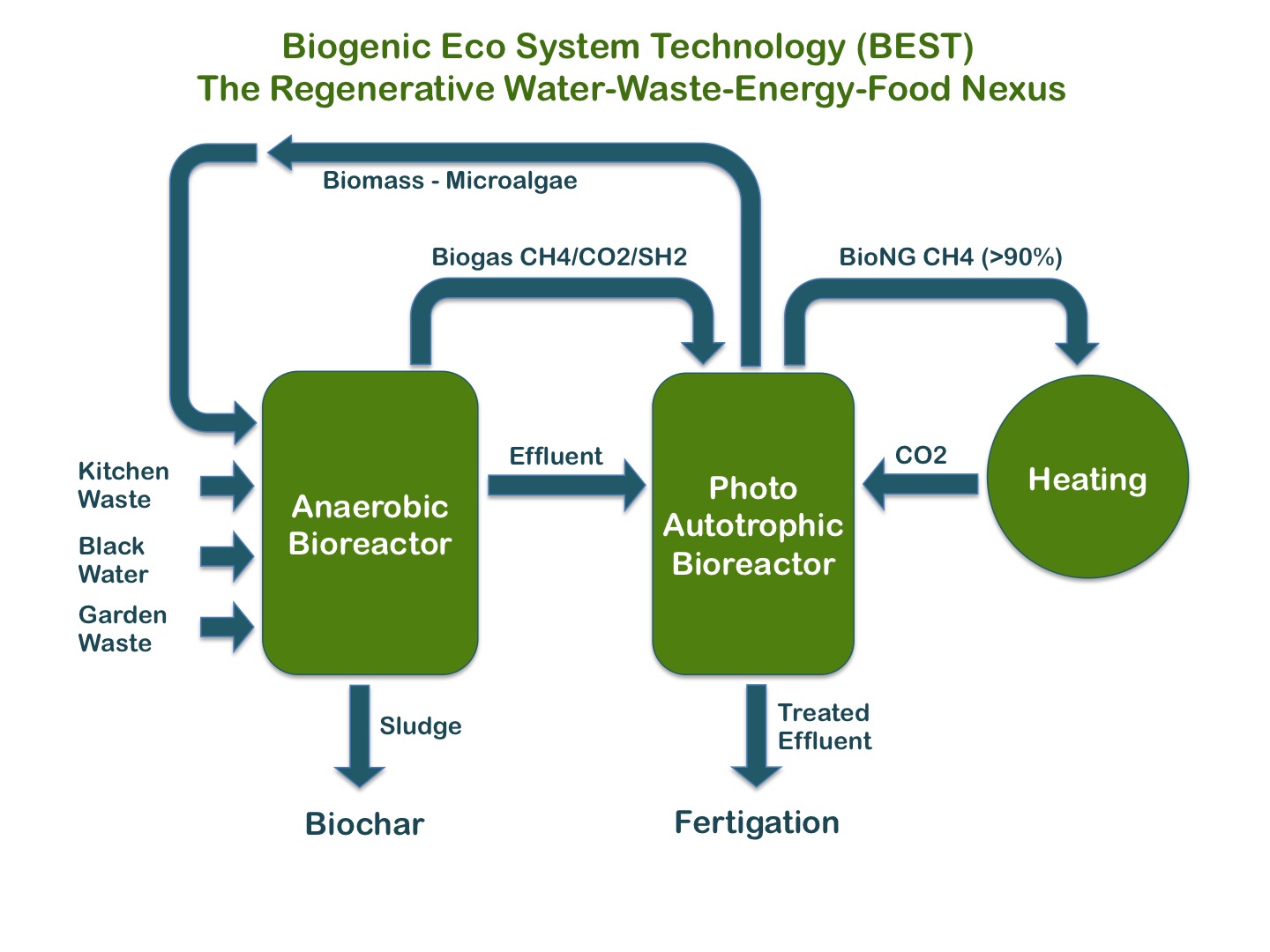
BioNG for Residential Hot Water And Cooking
With the vast natural gas (NG) infrastructure available globally there is much merit to continue its operation with biomethane or BioNG to accelerate the transition. In HOPEone we demonstrate a fully functional residential system powering a natural gas cooking stove and on demand water heater with BioNG. For this purpose the Biogas Organizing Module (BOM) was developed to purify the incoming biogas to natural gas standards without necessarily needing the photoautotrophic bioreactor and also to manage storage, distribution and automatic pressure regulation for the NG appliances. Furthermore, the BOM integrates a backup fuel option where LPG, propane or butane can be utilized to simulate NG. The domestic hot water system is primarily heated by a direct active thermal solar heat exchanger while a NG water heater supplements heat on demand.
Residential Biowaste Processing Produces Organic Fertilizer
One of the least efficiently utilized resources worldwide is biowaste. According to studies, human urine alone could provide 50% of the global fertilizer needs. In conjunction, with other kitchen wastes and septic wastes all the organic fertilizer needs can be generated to create a sustainable nutrient cycle. In HOPEone the residential biowaste including feces, food wastes, garden clippings and urine are broken down and treated by the 3-stage anaerobic bioreactor while reducing nutrient and pathogen content by over 90%. Thereafter the photoautotrophic bioreactor further treats the waste water removing another 75% of the remaining nutrients before being discharged into a subterranean leachfield to feed and water orchards. Alternately without a photoautotrophic bioreactor the effluent can be used to enrich thermophillic composting or disinfected and used as a NPK fertilizer. In other scenarios the biochar generated by the biomass gasifier could be enriched with greywater diluted urine as a carbon negative soil amendment. In addition, the sludge from the bioreactor if not used for gasification can be also thermophillicly composted to produce a rich organic fertilizer. In urban scenarios where fertilizer is not required, all biowastes can be used for biomass gasification which provides additional thermal energy and biochar while fixing carbon. Furthermore, the biochar can be stored as a backup fuel for the gasifier. It should be kept in mind though that this process is then considered only carbon neutral.
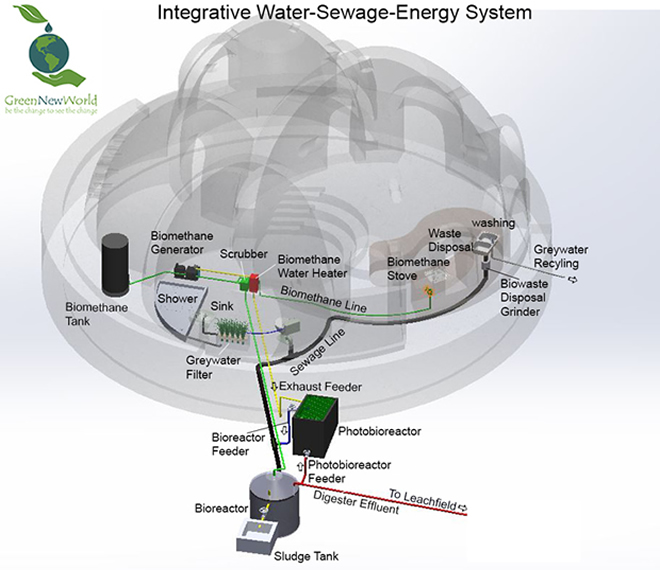
Photoautotrophic Bioreactor - Solar Powered Carbon Dioxide Scrubber
Microalgae produce biomass without using arable land to make bioenergy, bioplastics and food while consuming carbon dioxide and treating wastewater. Integration of a photoautotrophic bioreactor in HOPEone to grow microalgae provides a sustainable source of biomass to feed the anaerobic bioreactor for the production of BioNG. It provides system flexibility and robustness to produce sufficient amounts of BioNG to meet the residential demand. The photoautotrophic bioreactor is in symbiotic interaction with the anaerobic bioreactor so that no additional external input is required except light why it has been termed a Bionic Eco-System. It receives nutrients from the anaerobic reactor and provides biomass in return. Both reactors benefit from each other resulting in a 30% increase in BioNG production while providing other benefits such as removing impurities from biogas and further treating the wastewater. The HOPEone photoautotrophic bioreactor consumes as much CO2 as fifty trees at 1.5 - 2 kg per day. For every kilogram of microalgae grown, 1.8 kilograms of CO2 are consumed while generating 15,000 BTU or 4.4 kWh of energy. In the case where sufficient BioNG is already available the microalgae are dehydrated and either stored or used for biomass gasification as a carbon negative fuel.
Biomass Gasification - Carbon Negative Thermal Energy
There is much merit in developing residential biomass gasification systems as it is an established and efficient way to generate energy with biomass while sequestering carbon in the form of biochar. Carbon stored in the form of biochar is used for various applications such as greywater filter, the anaerobic filter and as a soil amendment to improve water and nutrient retention. In HOPEone an experimental biphasic fireplace-gasifier is being tested with multi-functional features including an oven, a backup domestic hot water heater, a thermoelectric generator and a dehydrator while the main function is to heat the house. The biobricks made from the anaerobic sludge are used as the primary fuel for the gasifier that is predominantly used during the winter. The sludge contains around 15% of the indegestible carbon from the anaerbic process which is subject to thermal carbonisation to prevent biodegradation. The end product of biomass gasification retains around 50% of the carbon as biochar which is predominantly used as a soil amendment to cultivate food. When biomass gasification is coupled to flue gas scrubbing more than 75% of the carbon can be sequestered as it is cycled in a closed loop through different modules until it is extracted as sludge and gasified again. Theoretically it is possible to sequester most of the carbon that enters the biowaste system by closed loop carbon cycling. HOPEone is providing us with valuable insight into these integrative systems.